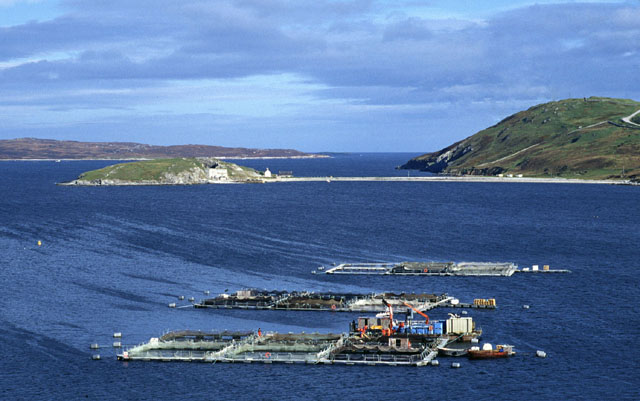
- Details
First published June 2007
Escapes happen. Particularly from the salmon farms that now adorn virtually ever sea lochs in the Scottish West Highlands and Islands. The impact of these escapees on native salmon populations threatens the survival of our wild fish. Over the past twenty years, wild salmon numbers have fallen by 45% whilst the production of farm fish has increased 55-fold. As more and more farm fish escape, fewer wild salmon survive.
Farm fish compete with wild salmon for a finite food and spawning habitat. Farm salmon may look similar to their wild cousins, but there the resemblance ends. When a wild salmon is 18 months old it is known as a smolt, weighs a few ounces and is about 6 inches long. It still lives in the river where it was born, having survived predation from other fish and fish-eating birds. Eventually, after approximately a further six months, the smolt migrates to the sea.
By comparison, a farmed salmon of 18 months has already been killed, filleted, sliced and is on a supermarket shelf. The farm fish is produced by artificial insemination and reared in a hatchery. Once it reaches smolt size, it is transferred to a freshwater cage where it feeds constantly and is inoculated against a raft of diseases. It is fed a diet high in fat and oil to make it grow as rapidly as possible when it is transferred to seawater cages. There, in close proximity to tens of thousands of other artificially-reared fish, it lives its brief life until slaughter.
Unless it escapes. If it does, it will try to emulate wild fish and find a river in which to breed. Male farm salmon are more aggressive in mating than wild salmon, and, thus, they out-compete wild fish. Where farm salmon successfully interbreed with wild fish, they reduce the genetic integrity of wild fish. The resultant progeny of their union are then less able to survive in the wild. This disability is transmitted down through the generations for as long as spawning continues. This is happening in Scotland and that is why escapee farm salmon pose such a threat to our wild fish.
The danger to wild salmon from farm salmon escapees is well documented. As far back as 1994, seven North Atlantic countries with fish farming industries (Canada, US, Norway, Scotland, Ireland, Iceland and the Faroes) signed the Oslo Agreement which included an undertaking to ‘minimise possible effects to wild salmon stocks from salmon aquaculture, and to minimise escapes of farmed salmon’.
A Sutherland Factory Fish Farm
 The measures proposed to achieve this end were sound and practical; including alternative production methods, such as closed or contained floating facilities; tagging and marking fish to determine the source of escapes and to assess the interactions of escaped farmed salmon on wild stocks; the establishment of protection areas where salmon farming is restricted or prohibited.
The measures proposed to achieve this end were sound and practical; including alternative production methods, such as closed or contained floating facilities; tagging and marking fish to determine the source of escapes and to assess the interactions of escaped farmed salmon on wild stocks; the establishment of protection areas where salmon farming is restricted or prohibited.
The Olso Agreement specifically addressed the matter cage design: “The design of aquaculture units should be appropriate for their assigned site so as to optimise the containment of fish. The risk of escape of fish from aquaculture units as a result of storm or ice damage should be minimised by using appropriate technology for the prevailing conditions.” But, more than a decade later, nothing has been done.
The Scottish Executive (SE) has failed in its duty to protect and preserve the nation’s wild salmonids; other, that is, than to commission endless reports, ever more scientific studies and to engage in what are basically futile consultations with so-called ‘stake-holders’. Indeed, it was only recently that the SE introduced legislation that compels fish farmers to report escapes from their farms.
It is hard to avoid the conclusion that there is a ‘hidden agenda’ behind this masterly inactivity on the part of Scottish Ministers, or to avoid the conclusion that the SE decided to sacrifice our West Highlands and Islands wild fish on the altar of the perceived economic and social benefits that fish farming was supposed to bring.
Indeed, as far back as the late 1980’s, The Nature Conservancy Council (predecessor body to Scottish Natural Heritage) warned government of the potential danger to wild stocks from fish farming.
Consequently, a decision seems to have been taken to confine fish farming to the West Highlands and Islands and to keep aquaculture development well away from Scotland’s major wild salmon rivers: Tweed, Tay, Spey and Dee; one of the only fish farm applications ever refused by the Crown Estate (owners of the seabed) for a seabed lease was in the Dornoch Firth, on the east coast. The application was rejected on the grounds that it would endanger wild fish as they passed by cages.
That such a decision exists has been consistently denied by the fish farmers, however, since 2004 it has become enshrined in the Scottish Executive’s National Planning Framework strategy, which notes, on page 79, “Locational restrictions have been placed on the farming of salmon to protect wild fish stock in the major Scottish rivers flowing to the East coast.” What a complete mockery that makes of all the hyped-up activities of Area Management Agreements and Fisheries Trusts. The Scottish Executive has condemned our West Highlands and Islands wild fish to death.


